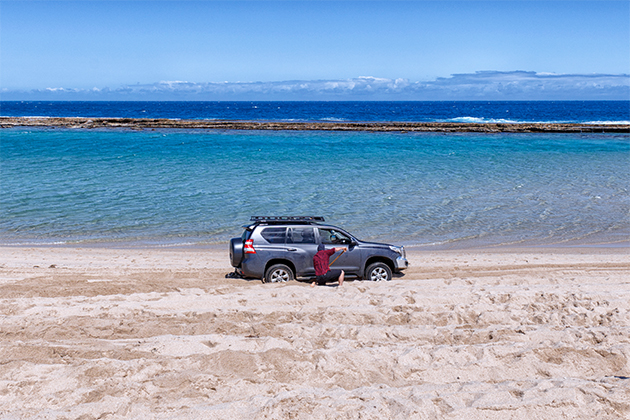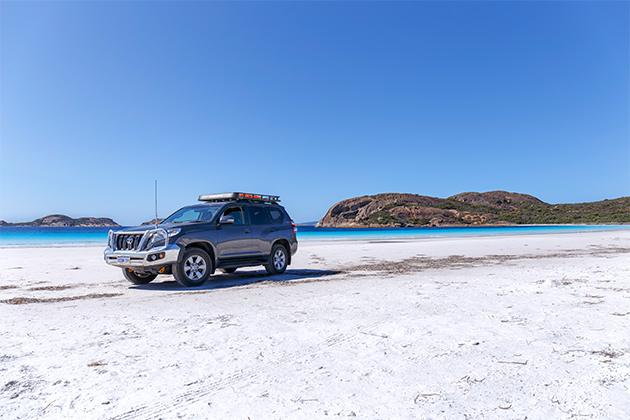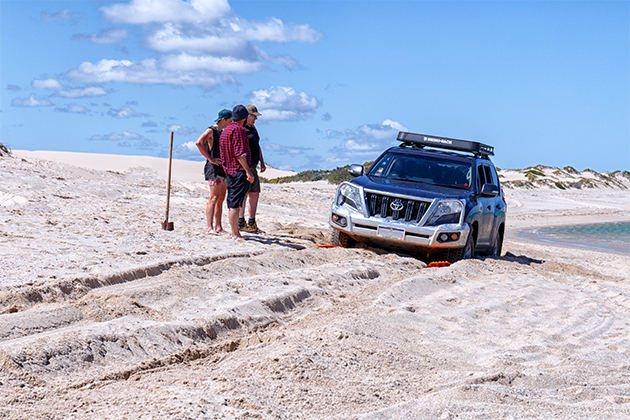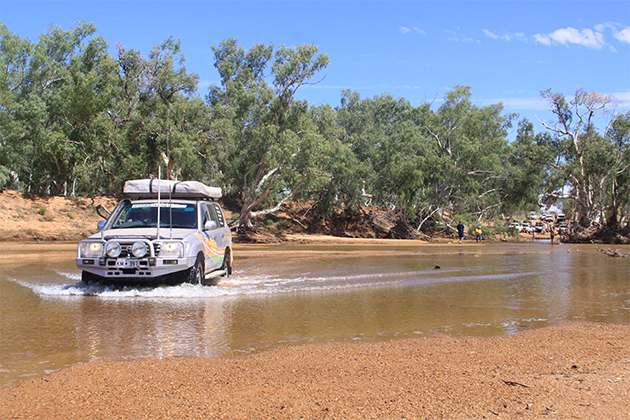By: Chris Morton
If you own a four-wheel drive that's been busy doing 'city duties', it might be time to get some West Aussie dirt on those tyres.
Take a quick look around our roads and it soon becomes apparent that Western Australians love their four-wheel drives. We love the high riding position they give us, and the perceived protection that a larger vehicle offers.
But it's likely that many four-wheel drives have rarely been used for their intended purpose: going off road.
The call to explore Western Australia, from its vivid red dirt to its snow-white beaches, has always been strong, and for many of us searching for new adventure outside our local communities, that call is now stronger than ever.
If you're planning to venture off the bitumen, it's critical that you start building up your knowledge now. We live in a very remote part of the world and help is not always readily available.
Having a good understanding of how to set up and use your four-wheel drive is essential to ensuring you can explore safely.
Important accessories
Like any leisure activity, the range, quality and price of accessories to make your four-wheel drive adventures safer and more enjoyable can be quite overwhelming.
Don't rush out and buy every accessory that's suggested to you. Take advice from trusted sources and buy good quality items. If it sounds cheap then it most likely is and you run the risk of the item failing when you need it the most.
For off-road driving, consider the following as a minimum:
- Tyre deflator
Being able to easily drop your tyre pressure is critical for crossing soft sand. It also reduces the impact to the track or terrain and helps prevent 'scalloping'.
Reducing tyre pressure is also the best way of making your drive more comfortable when travelling along corrugated roads.
- 12-volt air compressor
Pumping your tyres back to the correct pressures is essential for the safe operation of your vehicle. In the grand scheme of things this is probably one of the most important pieces of four-wheel drive equipment you will invest in.
- Carry a shovel
Not 'if' but 'when' you get bogged, you're going to need a shovel to dig yourself out.

- Recovery points
If you travel off road you will get stuck at some point. Ensure you have rated recovery points suitable for your vehicle (points at which you can attach a strap or cable). This is critical to ensure you don't damage your vehicle during a recovery and that you can do it safely.
Factory fitted points are not rated for kinetic recoveries such as snatching and winching. If you have a tow bar fitted and it has a Reece Hitch receiver (most do) then you can purchase a relatively inexpensive tow hitch recovery point.
Kinetic recoveries involve the transfer of energy from one mass (such as another vehicle), along a recovery strap or winch cable to a disabled vehicle. They can be dangerous and should only be attempted by those who are trained and experienced.
- Off-road tyres
Most new vehicles come fitted standard with highway tyres (usually designated with H/T on the sidewall). If you're taking your vehicle off road it's recommended that you swap them for something more suitable such as all-terrain tyres (A/T).
These still provide great on-road handling and performance and better off-road traction and control. They're also usually built stronger in the sidewall which provides extra stability when driving on lower pressure tyres.
- First Aid Kit
Always carry a First Aid Kit in your vehicle.
- Fire extinguisher
There are plenty of options available. Whatever you choose, make sure you can get to it quickly in your vehicle
- UHF radio
If you're going to be spending quite a bit of time off road then a good quality UHF radio is highly recommended. A fixed unit with an external antenna is best as it allows you to communicate much further than a handheld one.
Handling the vehicle and conditions
Modern four-wheel drives have some amazing technology built into them. Ensure you're familiar with the systems in yours by thoroughly reading its manual. Know how to engage and disengage four-wheel drive (if it's not a constant four-wheel drive system), and how and when to use high and low range.
When travelling off road, there are also scenarios where you'll need to know how to engage and disengage safety systems such as traction control and electronic stability control. These systems are fantastic when travelling along the bitumen but can cause issues when off road.
All drivers are taught to drive to the conditions. This is even more important when travelling off road.
Whenever there is a change of surface, such as transitioning from bitumen to gravel, slow down to maintain control.
When driving on gravel, brake before significant bends in the road while your wheels are still straight.
Trying to brake at speed when your wheels are not straight can have catastrophic consequences.
Driving at high speed over corrugations is dangerous. Your tyres have even less contact with the road than normal. Slow down and reduce your tyre pressure. This takes some of the burden off your suspension. A good rule of thumb is to stop regularly and check how hot your shock absorbers are. If they're too hot to touch, slow down and reduce your tyre pressures further.
Driving on the beach can be fun but momentum and tyre pressures are critical. If you're driving on the beach with more than 18psi in your tyres you will have issues. You shouldn't have more than 18psi in each tyre if driving on sand. Avoid high speeds and sudden changes of direction. If you're stopping for more than a few minutes, always come to a slow stop and roll backwards and forwards a few times to compress the sand beneath your tyres. Stay clear of the tide line and keep watch for sudden changes on the beach.

Getting out of tricky situations
Regardless of where you're going off road, take your time and think about what you're doing first. If a section of track looks challenging, get out of your vehicle and walk it first. If you're unsure that you can traverse it safely, look for an alternative.
It's recommended that you travel with at least one other vehicle, or more if you're going to remote locations. Communicating between vehicles via UHF radio in your group and with other road users is a great way to be forewarned of road conditions and potential hazards.
Bogged down
Getting bogged can strike fear into the hearts of the inexperienced and ill-equipped. There are plenty of reasons why a vehicle loses traction and becomes bogged, including using highway tyres instead of all-terrain tyres or tyre pressure that's too high when driving on sand.
Provided you're in a safe location, you have plenty of time to get yourself out. Stop and assess the situation. Do not spin your wheels. Check your tyre pressure, and if needed, take air out. This provides a greater surface area to not only spread the weight of the vehicle but the amount of traction your vehicle has.
If there's sand build up against the wheels and underneath the vehicle, dig it out. Place the car into low range and gently attempt to rock the car out by slowly applying power in forward and reverse.
In most cases this should extract the vehicle. In more severe cases you may need to use recovery boards or either winching or snatching the vehicle out with the assistance of another four-wheel drive.
When driving on sand, keep a constant and controlled speed. Sudden changes will cause the vehicle to lose momentum and bog down. When setting off from standstill, use gentle and steady pressure on the accelerator to avoid wheel spin.

Water crossings
Most vehicles are not designed to operate in water and crossing water should only be done with experience. All four-wheel drives have a manufacturer's specified wading or fording depth. That is the maximum depth of water it can drive through without causing damage to the vehicle. This is documented in your vehicle manual and can be easily found online.
The water crossing ability of your vehicle is measured assuming that the body of water is still (i.e. not a flowing river) and there are no sudden changes in depth. Once a vehicle enters a body of water it becomes buoyant and tends to float. This causes the vehicle to lose traction. Loss of traction results in loss of control and your vehicle is then under the control of the body of water you're in. This can quickly become a life-threatening situation.
If a water crossing cannot be avoided, then you should undertake the following steps:
- Walk through where you intend to cross if it's safe to do so, remembering that in the north of the State you can encounter saltwater crocodiles. If the water is moving too quickly to walk across then it's not safe to drive across.
- If possible, mark any deep holes or points that may prevent a safe crossing. Assess not only the crossing point but the entry and exit points as well. You must be confident that your vehicle can manage all sections of the crossing.
- Prepare your vehicle. Fit a water bra across the front of it. If you don't have one, then a tarp will do the same job. The purpose is to create a bow wave from the front of the vehicle as you enter the water.
- Drop your tyre pressure. Remember added traction is key when the surface is slippery.
- Prepare your recovery equipment. Have shackles and tow ropes/snatch straps already fitted and looped onto your bull bar or tied off where you can get to them quickly.
- If possible, disable the cooling fan in the engine bay to prevent it from sucking water in.
- Prepare an exit strategy. If you have electric windows, ensure at least one is wound down. If you have a sunroof, open it. These may be your only ways of exiting the vehicle in an emergency.
- Have all vehicles in your party ready to respond. If they have a winch, run the winch rope out so it's ready to attach to the disabled vehicle. If using tow ropes, ensure they're ready to quickly attach.

When you're ready to cross, go one vehicle at a time. If the car in front gets stuck, you'll also become stuck if you attempt to cross at the same time.
If driving an automatic, switch to manual mode and stay in the same gear so you don't lose momentum. If driving a manual select first or second and don't change gears. This is to prevent mud and water getting sucked into the clutch. And do not stop.
If you become stuck and the vehicle is not floating away, then you have time to re-assess. Try reversing and attempting a different approach through. If this fails, you'll need to call for assistance from others in your party. Remember you have exit points. If you need to, get everyone onto the roof of the vehicle and use your plan to get everyone to safety.
Once you're across, you may have water in your vehicle. Open doors and windows to allow drainage. Don't turn off the vehicle straight away. Give the engine bay time to dry out. Be aware that your brakes will be waterlogged. Gently use the brakes to remove excess water.
Always have a plan prior to attempting a water crossing. It could be the different between an adventurous part of your journey or a catastrophic end to it.
Travelling off the beaten track provides you with the opportunity to see some amazing sights that you might otherwise miss. If you own a four-wheel drive and have never taken it off road but want to, there are always ways for you to do so safely.
Consider joining a four-wheel drive club. Your membership will put you in contact with experienced four-wheel drive owners who love to explore.
Once you're prepared, the most important thing is to just get out there and find your next big adventure. Build memories with your family and friends. Discover what our State has to offer and use that four-wheel drive for what it was built for.
Getting help if you breakdown or get stuck
Before you start your four-wheel drive adventures, make sure you have the right level of RAC Roadside Assistance cover.
Ensure you have adequate towing distances, so you’re covered in country areas.
In the event that your vehicle needs to be recovered from a regional or remote area, you’ll also need to have “Extended benefits” included in your cover.
Just be aware that breakdowns on unsealed or non-trafficable roads and recovery of bogged vehicles will be attended at the discretion of the RAC or RAC contractors and excess costs are payable at the time of the service. This may include costs for any specialist equipment needed to recover the vehicle.
Find out more about what to do when you breakdown far from home.
Remember, while WA has many approved off-road driving tracks, off-road driving in some regional and remote areas is not permitted. For guides to approved tracks visit TrailsWA and search by trail type.
Last updated: March 2025
Image credit: Christine Arnasiewicz
Need a new 4WD battery?
You can rely on us to power your next 4WD adventure. Call us 24/7 for same day delivery.* Plus, members get 10% off.
*Same day delivery dependent on stock availability.
